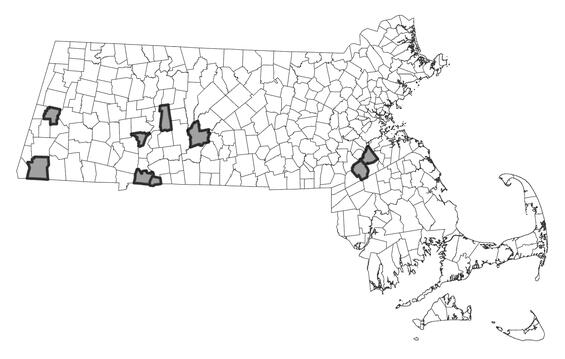- Scientific name: Claytonia virginica
- Species of Greatest Conservation Need (MA State Wildlife Action Plan)
- Endangered (MA Endangered Species Act)
Description
Narrow-leaved spring-beauty is a spring ephemeral wildflower of the Purslane Family (Portulacaceae), known in Massachusetts from rich forested floodplains. This delicate perennial has slender leaves and stems, which arise from underground bulb-like corms. Plants are 10-30 cm (4-12 in) in height. Leaves are green, entire, and linear to lance-shaped, tapering at both ends. Flower stems are light green and sometimes tinged with red. The leaves and stems are smooth and succulent. Up to 20 flowers may be borne on the stem in a loose raceme, subtended by a pair of opposite linear leaves. Each flower occurs on a long delicate stalk, 1-3 cm (0.4-1.2 in) long. Flowers are white or light pink with deep pink veins, 1.3-2 cm (0.5–0.8 in) across. Two firm green sepals subtend the petals. The fruit is a three-valved, smooth capsule containing 3 to 6 shiny black seeds. Each seed has a small fleshy attachment, known as an elaiosome, which facilitates dispersal and burial of the seed by ants. The name Claytonia was given to this genus by Linnaeus in recognition of John Clayton, a pioneering American botanist.
The leaves of narrow-leaved spring-beauty are generally much longer than wide, 6-20 cm (2-8 in) by 2 to 5 mm (0.08-0.2 in). Below the lowest pedicel of the flower cluster is a firm herbaceous bract, 2-10 mm (0.08-0.4 in) long and 2-6 mm (0.08-0.24 in) wide. Narrow-leaved spring-beauty flowers and fruits in early spring; by summer, the above-ground parts of the plant disappear.
Narrow-leaved spring-beauty is sometimes confused with Carolina spring-beauty (Claytonia caroliniana), a more common wildflower in Massachusetts. Carolina spring-beauty has much broader spatulate-shaped leaves, 3 to 6 cm (1.2-2.4 in) long and 1-1.5 cm (0.04-0.06) wide but sometimes longer and wider. Also, the bract subtending the lowest flower pedicel of Carolina spring-beauty is dry and very thin, 1.5 to 3 mm (0.06-0.12 in) long and broad.
Life cycle and behavior

Narrow-leaved spring-beauty flowers in early spring, generally late April through mid-May. Fruiting capsules mature May to early June. The above ground parts of this ephemeral wildflower disappear by early June.
Population status
Narrow-leaved spring-beauty is listed under the Massachusetts Endangered Species Act as Endangered. All listed species are legally protected from killing, collection, possession, or sale, and from activities that would destroy habitat and thus directly or indirectly cause mortality or disrupt critical behaviors. The MassWildlife’s Natural Heritage & Endangered Species Program database has 18 records from 6 counties: Barnstable, Berkshire, Franklin, Hampden, Hampshire, Middlesex, and Norfolk. Nine of these records have been observed within the last 25 years.
Distribution and abundance
Narrow-leaved spring-beauty is found from Nova Scotia, Quebec, and Ontario to Minnesota, Georgia, Louisiana, and Texas.

Distribution in Massachusetts
1999-2024
Based on records in the Natural Heritage Database
Habitat
Narrow-leaved spring-beauty typically occurs in deciduous forests on upper floodplain terraces and adjacent toe slopes. These areas have moist fertile soils and are subject to infrequent flooding events. Plants are often found under a canopy of red maple (Acer rubrum), silver maple (A. saccharinum), sugar maple (Acer saccharum), shagbark hickory (Carya ovata), American ash (Fraxinus americana), and black cherry (Prunus serotina). Ironwood (Carpinus caroliniana) is a common subcanopy associate with scattered arrowwood (Viburnum dentatum), nannyberry (Viburnum lentago), and winterberry (Ilex verticillata) in the shrub layer. Common herbaceous plants found with narrow-leaved spring-beauty are trout lily (Erythronium americanum), Dutchman’s breeches (Dicentra cucullaria), ostrich fern (Matteuccia struthiopteris), bloodroot (Sanguinaria canadensis), nodding trillium (Trillium cernuum), and red trillium (T. erectum).
Healthy habitats are vital for supporting native wildlife and plants. Explore habitats and learn about conservation and restoration in Massachusetts.
Threats
Disruption of natural flood regimes and sedimentation patterns on adjacent rivers and streams may change soil moisture, limit the deposition of important nutrients, and cause shifts in understory plant composition. High-terrace floodplain forests and adjacent buffers are vulnerable to clearing and conversion for agriculture and other intensive land uses, and to invasion by exotic invasive plant species. Aggressive native and exotic plant species may compete with narrow-leaved spring-beauty for light and nutrients. Some invasive species, such as garlic mustard (Alliaria petiolata), are allelopathic, meaning they can change the soil chemistry to inhibit the viability of native plants. Additional exotic species of concern within this habitat type include multiflora rose (Rosa multiflora), Japanese barberry (Berberis thunbergii), shrub honeysuckles (Lonicera tatarica, L. morrowii, and L. x bella), glossy buckthorn (Rhamnus frangula), moneywort (Lysimachia nummularia), and reed canary grass (Phalaris arundinacea). Overgrazing by cattle and recreational uses, such as off-road vehicle use, may cause soil erosion or compaction, and physically harm plants.
Conservation and management
As with all species, maintaining habitat quality is essential. Narrow-leaved spring-beauty populations should be monitored to gain a better understanding of population dynamics and threats at each site. The natural hydrologic regime should be preserved to ensure sustained, nourished, high quality habitat for this rare plant. Suitable habitats should be inventoried for additional, undocumented populations of narrow-leaved spring-beauty.
Population locations that receive heavy recreational use (e.g., hiking, off-road vehicles) should be carefully monitored for plant damage or soil disturbance; trails can sometimes be re-routed to protect the rare plant population. Narrow-leaved spring-beauty habitat should be monitored for competition and over-shading by aggressive native and exotic invasive plants. If exotic plants are invading narrow-leaved spring-beauty habitat, a plan for control should be constructed. All active management within the habitat of a rare plant population (including invasive species removal) is subject to review under MESA and should be planned in close consultation with MassWildlife’s Natural Heritage & Endangered Species Program.
Contact
| Date published: | April 10, 2025 |
|---|